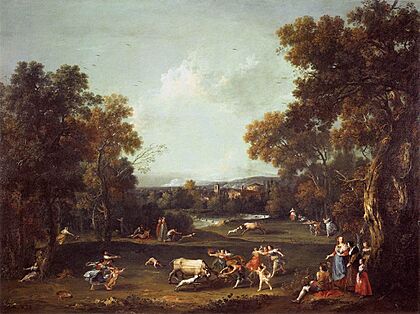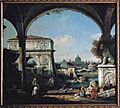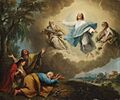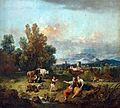Francesco Zuccarelli facts for kids
Quick facts for kids
Francesco Zuccarelli
|
|
|---|---|
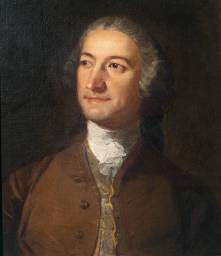
Portrait of Zuccarelli by Richard Wilson
|
|
| Born |
Giacomo Francesco Zuccarelli
15 August 1702 Pitigliano
|
| Died | 30 December 1788 (aged 86) |
| Known for |
|
| Movement | Rococo |
| Patron(s) | Joseph (Consul) Smith |
Francesco Zuccarelli (born Giacomo Francesco Zuccarelli, August 15, 1702 – December 30, 1788) was an Italian painter. He was famous for his beautiful landscape paintings during the late Baroque and Rococo periods. Many people think he was the most important landscape painter from Venice in the 1700s. His "Arcadian" paintings, which showed peaceful, ideal countryside scenes, were very popular across Europe, especially in England. He lived there for two long periods.
Rich and powerful people, including nobles, supported his work. He often worked with other artists like Antonio Visentini and Bernardo Bellotto. In 1768, Zuccarelli helped start the Royal Academy of Arts in London. When he returned to Italy, he became the president of the Venetian Academy. Besides his country landscapes, which often included religious or classical stories, Zuccarelli also painted religious art and sometimes portraits. He also made etchings, drawings, and designs for tapestries. He even designed a set of playing cards based on the Old Testament.
Even though Zuccarelli was very famous when he was alive, his popularity went down in the early 1800s. This happened because a new style called naturalism became more popular in landscape painting. Later, in 1959, an art historian named Michael Levey explained why Zuccarelli's art was so popular in England. He said Zuccarelli's best work was very decorative. More recently, since the 1990s, Italian experts have shown new interest in Zuccarelli. His paintings and drawings are now often shown in art exhibitions.
Contents
Early Life and Art Training (1702–1732)
Giacomo Francesco Zuccarelli was born in Pitigliano, a town in southern Tuscany, Italy. He was born on August 15, 1702. His father, Bartolomeo, was quite wealthy and owned several vineyards. He also had a shop that sold kitchen tools and spices.
Around age eleven or twelve, Zuccarelli started learning art in Rome. He trained with portrait painters Giovanni Maria Morandi and his student Pietro Nelli. Here, he learned the basics of drawing and painting. He also learned about the classical Roman art style.
From 1725 to 1727, Zuccarelli completed his first big art job in his hometown. He painted two altarpieces for a chapel. From 1728 to 1731, he focused on making etchings. An art expert from Florence, Niccolò Gabburri, supported him during this time. Zuccarelli created at least 43 prints. Most of these prints showed old frescoes by other artists. During his five years in Florence, he started drawing landscapes. Some of these drawings are now kept at the Uffizi museum. An artist named Paolo Anesi was a key teacher for Zuccarelli in landscape painting. This type of painting later made him famous.
Becoming Famous in Venice (1732–1752)
In 1732, Zuccarelli moved to Venice after a short stay in Bologna. At that time, a famous landscape painter named Marco Ricci had recently passed away. This created a chance for Zuccarelli to become a leading landscape artist. While he still painted religious and mythological scenes, he focused more and more on landscapes. He found inspiration in the classical style of artists like Claude Lorrain.
His early paintings from the 1730s show the influence of Ricci. Zuccarelli used softer, brighter colors than other Venetian painters. He made the figures in his peaceful landscapes look very lively. He quickly became successful in Venice. Important people like Marshal Schulenburg and Joseph (Consul) Smith supported him. Consul Smith became his long-time supporter.
In 1735, Zuccarelli married Giustina Agata Simonetti in Venice. They had four daughters and two sons. He often worked with other artists, including Bernardo Bellotto and Antonio Visentini. With Consul Smith's help, Zuccarelli and Visentini created a series of paintings in the mid-1740s. These paintings featured buildings in the neo-Palladian style, like Burlington House (1746).
One interesting project they did together was a set of 52 playing cards in 1748. These cards showed scenes from the Old Testament. The scenes were hand-colored and had a light, playful feel. The suits were circles, diamonds, hearts, and jars. The cards started with the creation of Adam and ended with a battle scene.
A major achievement from his first time in Venice was a series of seven paintings. These are now at Windsor Castle. They show biblical characters like Rebecca with Jacob and Esau. These tall paintings are delicate and dream-like. They were probably first displayed at Consul Smith's home. Zuccarelli also sometimes copied the styles of 17th-century Dutch masters.
From 1748 to 1751, Zuccarelli often visited Bergamo. He was invited by his friend Francesco Maria Tassi. There, he painted three portraits that are now in the Accademia Carrara. Around this time, Zuccarelli started using bright colors in a way that showed different moods. His paint was applied thinly, but it still looked vibrant.
In 1751, the artist Richard Wilson painted a portrait of Zuccarelli in Venice. Zuccarelli helped convince Wilson to switch from painting portraits to landscapes. The next year, Zuccarelli talked about painting techniques with Joshua Reynolds. Zuccarelli believed that famous Renaissance painters like Paolo Veronese and Tintoretto painted on a special white base called gesso. He thought Titian did not.
First Time in England (1752–1762)
Zuccarelli was persuaded to travel to England, possibly by the royal librarian, Richard Dalton, and Consul Smith. A beautiful painting from his early time in England, dated 1753, shows a happy country festival. His "Arcadian" style remained his most famous. In this style, nature is shown as a pleasant, ideal place, full of beauty and love.
His talent for decorative art led to many different projects. He designed tapestries with the weaver Paul Saunders for Holkham Hall. Based on these tapestry designs, Zuccarelli was asked in 1758 to create paintings with Oriental themes. One example is Pair with Dromedary.
By November 1757, Zuccarelli had become a member of the Society of Dilettanti. In 1760, he painted Et in Arcadio Ego, a work that a poet called an "admirable picture." In the same year, Zuccarelli painted a scene from Shakespeare's play Macbeth. It showed Macbeth and Banquo meeting the three witches. This was one of the first paintings to show theater characters in a landscape. The idea for this painting might have come from the actor David Garrick's performances of Macbeth.
During this period, he also started painting vedute, which are detailed city views. Examples include A View of the River Thames from Richmond Hill looking towards Twickenham and the View of Vicenza with Ancient Monuments. In 1762, Zuccarelli held a sale of his paintings in London before he left for Italy. The paintings for sale included religious scenes, a portrait, the Four Seasons, and an Arabian horse. Also in 1762, King George III bought thirty of Zuccarelli's works. These were part of a large art collection and library that the King bought from Consul Smith in Venice.
Short Return to Venice (1762–1764)
Zuccarelli arrived back in Venice in September 1762. He became a member of the Venetian Academy in 1763. There is only one known painting from this time: the academic St. John the Baptist. He was required to paint this to join the academy. Zuccarelli was encouraged to go back to London in 1764. This was because his friend Algarotti left a cameo and some drawings to Lord Chatham in his will.
Second Time in England (1765–1771)
On his second visit to England, Zuccarelli was highly praised by English nobles and art critics. He was invited to show his work at important art societies. He continued to find inspiration from different sources. For example, a painting in a private collection shows a peasant woman feeding her child in a landscape. This painting shows influences from Flemish-Dutch artists, Nordic clothing, and hints of Thomas Gainsborough. Gainsborough was one of Zuccarelli's favorite artists in the 1760s.
Zuccarelli showed his paintings at exhibitions held by the Free Society of Artists in 1765, 1766, and 1782. In 1767, his painting Macbeth and the Witches, probably a third version, was shown at The Society of Artists. The Journey of Jacob was also displayed. These two paintings had different styles. Macbeth had quick, almost unfinished brushstrokes, while Jacob showed great attention to detail. Macbeth later became widely known through an engraving made in 1770.
In 1768, Zuccarelli was a founding member of the Royal Academy of Arts. King George III asked him to paint a very large painting called River Landscape with the Finding of Moses (1768). This was a special honor, as no other Italian artist was given such a task. The painting was perfect in its style and clearly showed the influences of Gaspard Dughet and Claude Lorrain.
In 1769, Zuccarelli showed two landscapes and figures at the Royal Academy's first exhibition. In 1770, he showed three landscapes, a St. John Preaching in the Wilderness, and a Holy Family. In 1771, he exhibited another Holy Family. The Finding of Moses was shown in 1773, two years after he left for Italy.
Last Years in Italy (1771–1788)
When Zuccarelli returned to Venice in 1771, he was welcomed with warmth and pride. In September of that year, the art community made him director of the Academy of Fine Arts of Venice. The next month, he became president. Now in his seventies, he started to paint differently. He moved away from his usual Arcadian landscapes. Instead, he adopted a style that was more popular in Venice at the time, called neoclassical. This style reminded people of his earlier work, when he copied Ricci.
One of his later masterpieces is the unusual Landscape with Bridge, Figures, and a Statue. This painting follows the style of Francesco Guardi, who created capricci (fantasy landscapes) with a romantic mood. Zuccarelli's painting also gently makes fun of Guardi by placing the statue right in the middle. The painting has many elements typical of Zuccarelli, like a fisherman, a waterfall, a bridge with animals, a traveler, and a peasant. But it is painted with quick brushstrokes, a style common in this period. The mood of the painting is sad, similar to his earlier Macbeth and the Witches.
Another beautiful painting is Banquet of a Villa. It shows people dining outdoors at a festive table. This painting is realistic, like the work of Pietro Longhi. The parallel and sloping lines of the landscape are typical of English landscape artists. Zuccarelli's continued desire to try new approaches, even as he got older, might explain why he wasn't very interested in his role as president of the Venetian Academy. He was often absent from meetings. In 1774, he left permanently for Florence without telling anyone, which upset the academy members.
Zuccarelli stayed in touch with Great Britain. In 1775, he was asked to paint four pictures for Wedderburn Castle in Scotland. These paintings were based on engravings of the ruins of Palmyra, which were published in 1753. The small figures in Turkish style standing among the classical ruins are similar to other oriental scenes he painted later in life.
Since his youth, Zuccarelli had been a member of the Florentine Academy of Design. In 1777, he was made "Master of Nudes" at the academy. This was a more important title than being a landscape painter, which was considered a minor art form at the time. Figure drawing was seen as more important. Zuccarelli continued teaching at the academy until it was reorganized in 1784.
In his will from 1787, Zuccarelli left everything to his "beloved wife" Giustina. He died in Florence on December 30, 1788. His long obituary in the Gazzetta Toscana described him as "straightforward, humble, grateful, compassionate, generous." It also noted that he had a "natural genius" for landscapes since he was young.
Fame and Influence
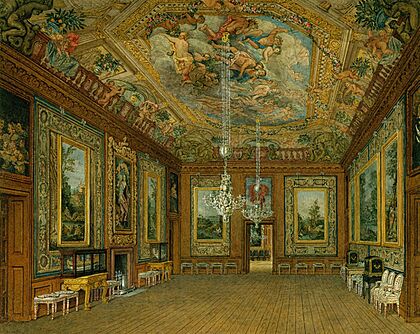
Zuccarelli was one of the few Venetian painters of his time who was praised by almost everyone. Even critics who didn't like the idea of "Arcadia" admired his work. He was especially popular among followers of Jean-Jacques Rousseau. Francesco Maria Tassi, a writer from the 1700s, said that Zuccarelli painted "landscapes with the most charming figures." He believed Zuccarelli was better than modern artists and even rivaled great artists from the past. Tassi said Zuccarelli knew how to combine beautiful backgrounds with gracefully posed figures in natural colors.
In the 1800s, as art moved towards more realistic landscapes, people started to criticize Zuccarelli's work. The art historian Michael Levey wrote about this in 1959. J. M. W. Turner said Zuccarelli's work was "showy" and lacked the charm of Jean-Antoine Watteau, but he admitted Zuccarelli's figures were "sometimes beautiful." Victorian writers, who supported Richard Wilson, thought Zuccarelli's work was too dramatic and not sincere.
Levey helped people see Zuccarelli's art in a new way. He explained that Zuccarelli's paintings were popular because they were like the pastoral poetry that English people loved in the 1700s. They showed a "fairyland where the skies are forever blue, the trees forever green." This idea of country life as a peaceful escape from city life had a long history. Levey said that Zuccarelli's best work is very decorative and can still bring joy. While he was not much discussed in Italy for a long time, he never lost favor there as he did in England. In recent decades, Italian experts have shown renewed interest in Zuccarelli.
Many artists copied Zuccarelli's style in the mid to late 1700s. These included Richard Wilson, Giuseppe Zais, and Giovanni Battista Cimaroli. Many engravers also made prints based on his work, such as Joseph Wagner and William Woollett.
The Francesco Zuccarelli Municipal Library and Historical Archives is located in Pitigliano, Zuccarelli's hometown. The Museum of the Orsini Palace nearby also displays Zuccarelli's earliest altarpieces.
How to Identify His Paintings
Zuccarelli rarely signed his paintings. However, his works often include a gourd water bottle. This bottle was carried by country women in Italy. It was a clever play on his last name, as zucco is the Italian word for gourd. A clear sign of Zuccarelli's work throughout his career is the calm, slightly sweet expression on the faces of his rounded figures.
Images for kids
-
Landscape with the Penitent Magdalene. c. 1728. Drawing. British Museum.
-
Lorenzo Lippi, after a drawing by Filippo Baldinucci. Florence, 1731.
-
Self-portrait. Drawing in chalks. 1736 or 1738. Royal Academy of Arts, London.
-
Roman Capriccio with Triumphal Arch, the Pyramid of Cestius, St. Peter's Basilica and the Castle of the Holy Angel. Bernardo Bellotto and Francesco Zuccarelli. Mid–1740s. Galleria nazionale, Parma.
-
Burlington House. Antonio Visentini and Francesco Zuccarelli. 1746. Windsor Castle, Windsor.
-
Cicero Finds the Tomb of Archimedes. 1747. Sanssouci, Potsdam.
-
Old Testament Playing Cards. Francesco Zuccarelli and Antonio Visentini. Venice, 1748. British Museum.
-
Ruins of Palmyra. Wool and silk tapestry by Paul Saunders, designed by Francesco Zuccarelli. 1758. V&A Museum, London.
-
Garden party. After 1762. Fondation Bemberg, Toulouse.
-
Mountain Landscape with Washerwomen and a Fisherman. c. 1765–8. National Gallery of Art, Washington, D.C.
-
River Landscape with the Finding of Moses. 1768. Windsor Castle, Windsor.
-
The Zuccarelli Room in 1880, looking South West. Windsor Castle, Windsor.



